The Simple Present Tense: Everyday English!
Hello, amazing learners! Welcome to a super fun journey into English grammar. Today, we’re going to explore something very important: The Simple Present Tense. Don’t worry, it’s much easier than it sounds! In fact, it’s one of the most common and useful tenses in English. Understanding it will truly help you express yourself clearly and confidently every single day.
नमस्ते, अद्भुत शिक्षार्थियों! अंग्रेजी व्याकरण की एक शानदार यात्रा में आपका स्वागत है। आज, हम कुछ बहुत महत्वपूर्ण सीखने जा रहे हैं: Simple Present Tense (सामान्य वर्तमान काल)। चिंता मत करो, यह जितना लगता है उससे कहीं ज़्यादा आसान है! दरअसल, यह अंग्रेजी के सबसे सामान्य और उपयोगी कालों में से एक है। इसे समझना आपको हर दिन स्पष्ट और आत्मविश्वास से खुद को व्यक्त करने में वास्तव में मदद करेगा।
Think about what you do every day, or things that are always true. That’s exactly where the Simple Present Tense comes in! It helps us talk about habits, routines, facts, and scheduled events. Ultimately, mastering this tense is a crucial step in building strong English communication skills.
What is the Simple Present Tense?
The Simple Present Tense talks about actions that happen regularly, habitually, or are generally true. It also describes facts and scheduled events. We use the base form of the verb for most subjects, but we add an ‘-s’ or ‘-es’ for third-person singular subjects (he, she, it). Therefore, it’s also known as Present Simple. This tense is the backbone of daily conversation and writing. For instance, when you talk about your morning routine, you’ll naturally use the Simple Present T Tense.
Simple Present Tense उन क्रियाओं के बारे में बताता है जो नियमित रूप से, आदतन होती हैं, या आमतौर पर सच होती हैं। यह तथ्यों और निर्धारित घटनाओं का भी वर्णन करता है। हम अधिकांश विषयों के लिए क्रिया के मूल रूप का उपयोग करते हैं, लेकिन तीसरे व्यक्ति एकवचन विषयों (he, she, it) के लिए हम ‘-s’ या ‘-es’ जोड़ते हैं। इसलिए, इसे Present Simple के नाम से भी जाना जाता है। यह काल दैनिक बातचीत और लेखन की रीढ़ है। उदाहरण के लिए, जब आप अपनी सुबह की दिनचर्या के बारे में बात करते हैं, तो आप स्वाभाविक रूप से Simple Present Tense का उपयोग करेंगे।
Let’s dive a little deeper! The Simple Present Tense is fundamentally used to express actions that are continuous or repetitive in nature. For example, “The sun rises in the east” is a universal truth, and “I brush my teeth every morning” is a routine. Furthermore, this tense is often accompanied by adverbs of frequency like ‘always,’ ‘often,’ ‘sometimes,’ ‘usually,’ ‘never,’ and ‘every day.’ These words significantly help in indicating the regularity of an action. Understanding these core uses will undoubtedly enhance your ability to communicate effectively.
When Do We Use It? (Its Uses)
We use the Simple Present Tense for several key reasons. Here’s a breakdown:
-
For Habits and Routines: Things you do regularly.
आदतों और दिनचर्या के लिए: जो काम आप नियमित रूप से करते हैं।
I drink coffee every morning.
She always studies before an exam.
-
For Facts and General Truths: Things that are always true.
तथ्यों और सामान्य सत्यों के लिए: जो बातें हमेशा सच होती हैं।
The Earth revolves around the sun.
Water freezes at 0 degrees Celsius.
-
For Scheduled Events in the Future: Especially for public transport, movie times, etc.
भविष्य में निर्धारित घटनाओं के लिए: विशेष रूप से सार्वजनिक परिवहन, फिल्मों के समय आदि के लिए।
The train leaves at 7 PM.
The concert starts at 8 o’clock.
-
For Instructions or Directions: Giving commands or guiding someone.
निर्देशों या दिशा-निर्देशों के लिए: आदेश देना या किसी को मार्गदर्शन करना।
First, you open the box. Then, you mix the ingredients.
Moreover, it’s also used in sports commentary, dramatic narration, and headlines, further highlighting its versatility. For example, “Player scores a goal!” clearly uses the Simple Present. Therefore, understanding these diverse applications is truly beneficial for comprehensive language learning.
Forming the Simple Present Tense (How to Make It)
Forming the Simple Present Tense is quite simple once you know the basic rules. Essentially, it uses the base form of the verb for most subjects. However, there’s a small but significant change for specific subjects.
Simple Present Tense बनाना काफी आसान है एक बार जब आप बुनियादी नियम जान जाते हैं। मूल रूप से, यह अधिकांश विषयों के लिए क्रिया के मूल रूप का उपयोग करता है। हालांकि, विशिष्ट विषयों के लिए एक छोटा लेकिन महत्वपूर्ण बदलाव है।
Positive Sentences (Affirmative)
For subjects I, You, We, They, and plural nouns, we use the base form of the verb (the verb as it is). Generally speaking, this is the easiest part.
I play.
You read.
We study.
They work.
Birds sing.
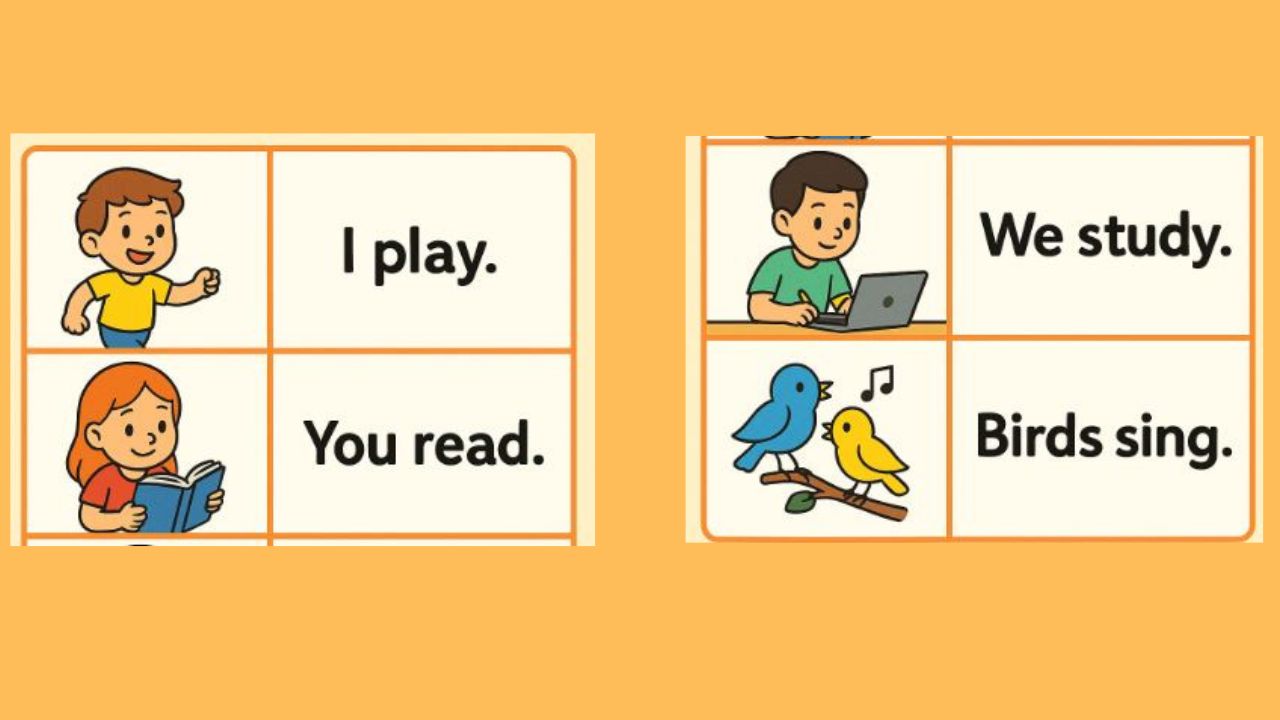
For subjects He, She, It, and singular nouns, we add -s or -es to the base form of the verb. This rule is particularly important to remember. Consequently, mistakes often occur here.
He plays.
She reads.
It works.
The cat sleeps.
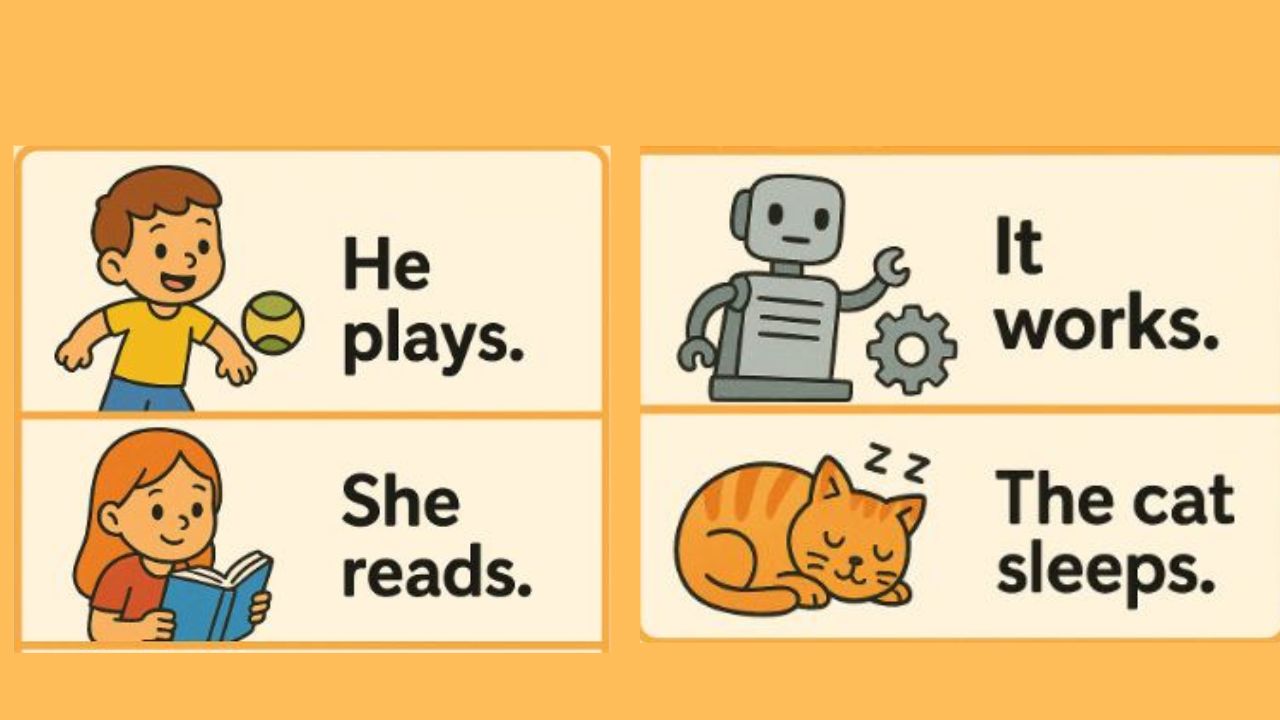
Spelling Rules for -s / -es Endings:
- Most verbs: Add -s. (e.g., walk → walks, eat → eats)
- Verbs ending in -ss, -sh, -ch, -x, -o: Add -es. (e.g., kiss → kisses, wash → washes, watch → watches, fix → fixes, go → goes)
- Verbs ending in a consonant + y: Change ‘y’ to ‘i’ and add -es. (e.g., study → studies, cry → cries)
- Verbs ending in a vowel + y: Just add -s. (e.g., play → plays, enjoy → enjoys)
Negative Sentences (Making it “Not”)
To make a sentence negative in the Simple Present Tense, we use do not (don’t) or does not (doesn’t) before the base form of the verb. Interestingly, the verb itself never changes to include ‘-s’ or ‘-es’ when ‘does not’ is used. This is a common point of confusion.
Simple Present Tense में वाक्य को नकारात्मक बनाने के लिए, हम क्रिया के मूल रूप से पहले do not (don’t) या does not (doesn’t) का उपयोग करते हैं। दिलचस्प बात यह है कि ‘does not’ का उपयोग होने पर क्रिया में कभी भी ‘-s’ या ‘-es’ नहीं जुड़ता है। यह अक्सर भ्रम का एक बिंदु होता है।
-
For I, You, We, They, and plural nouns: Use do not (don’t).
I do not play. (I don’t play.)
They do not live here. (They don’t live here.)
-
For He, She, It, and singular nouns: Use does not (doesn’t).
He does not read. (He doesn’t read.)
She does not work on Sundays. (She doesn’t work on Sundays.)
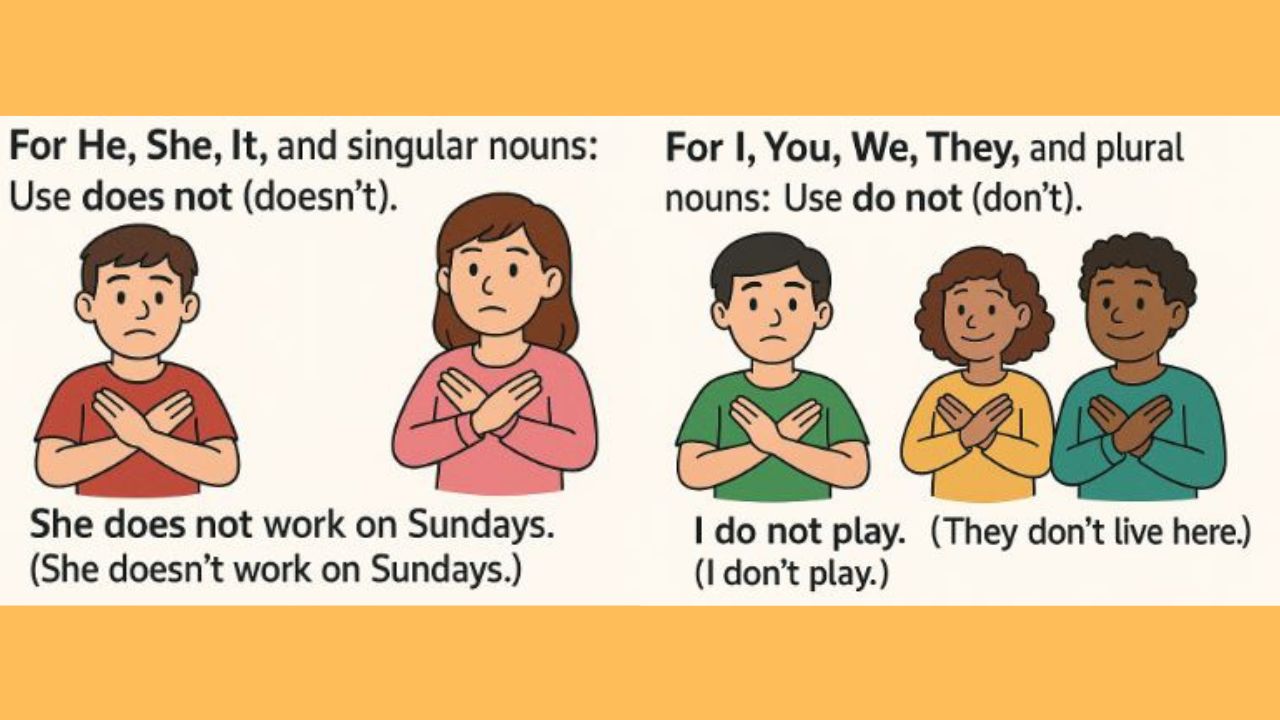
Question Sentences (Asking Questions)
To ask a question in the Simple Present Tense, we use Do or Does at the beginning of the sentence, followed by the subject and then the base form of the verb. Remember, just like in negative sentences, the main verb never changes its form (no -s or -es) when ‘Does’ is used.
Simple Present Tense में प्रश्न पूछने के लिए, हम वाक्य की शुरुआत में Do या Does का उपयोग करते हैं, जिसके बाद विषय और फिर क्रिया का मूल रूप आता है। याद रखें, नकारात्मक वाक्यों की तरह, मुख्य क्रिया कभी भी अपना रूप (कोई -s या -es नहीं) नहीं बदलती जब ‘Does’ का उपयोग किया जाता है।
-
For I, You, We, They, and plural nouns: Use Do at the start.
Do you like pizza?
Do they speak English?
-
For He, She, It, and singular nouns: Use Does at the start.
Does he live nearby?
Does she understand the lesson?
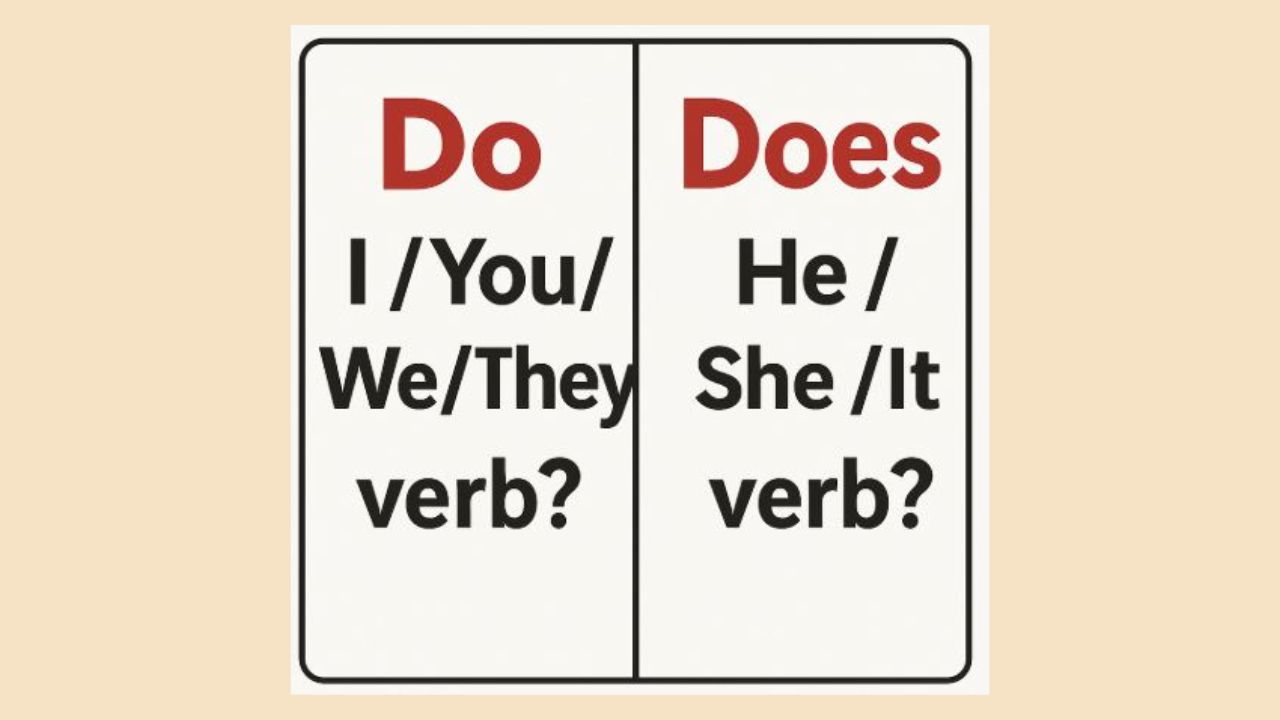
Common Rules and Tips for Simple Present Tense
Here are some practical and memorable rules to help you master the Simple Present Tense. Remembering these tips will significantly improve your accuracy. Furthermore, consistent practice makes perfect!
-
Always Check the Subject: Before you write or speak, always identify the subject of your sentence. Is it “I,” “you,” “we,” “they,” or a plural noun? Or is it “he,” “she,” “it,” or a singular noun? This distinction is absolutely crucial for deciding whether to add -s/-es.
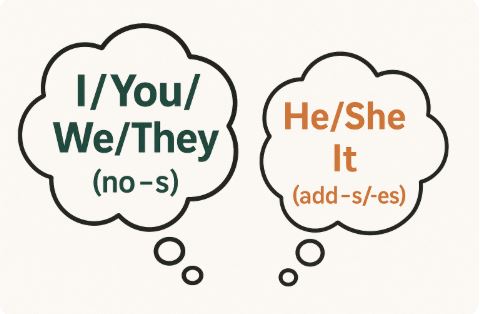
- Keywords are Your Friends: Look for adverbs of frequency like always, often, usually, sometimes, rarely, never, every day, every week, on Mondays, at night. These words are strong signals that you probably need the Simple Present Tense.
-
“Do” and “Does” are Helpers: Remember that ‘do’ and ‘does’ are helping verbs for negatives and questions. The main verb stays in its base form when ‘do/does’ or ‘don’t/doesn’t’ are present.
Correct: He does not eat meat. (NOT: He does not eats meat.)
-
Be Careful with “To Be”: The verb “to be” (am, is, are) does NOT use “do/does” for questions or negatives.
Correct: She is happy. Is she happy? She is not happy.
Incorrect: Does she be happy? She does not be happy.
- Practice, Practice, Practice: The more you use it, the easier it becomes! Try to describe your daily routine in English using the Simple Present Tense. This hands-on approach is truly effective.
Frequency Adverbs
How often something happens
- 100% Always 🌞 I always brush my teeth.
- 80% Usually 📅 We usually play football.
- 60% Often ⭐⭐⭐ They often watch TV.
- 40% Sometimes ⚪◐ She sometimes eats pizza.
- 20% Rarely ⭐ He rarely drinks soda.
- 0% Never 🚫 She never smokes.
Exercise 1: Fill in the Blanks
Complete the sentences using the correct form of the verb in parentheses. Consequently, pay close attention to the subject!
- My sister often ___________ (listen) to music.
- They ___________ (go) to the park every Sunday.
- He ___________ (teach) English at a school.
- We ___________ (not / like) spicy food.
- ___________ (do / you / watch) TV in the evenings?
- The sun ___________ (rise) in the east.
- She ___________ (not / play) tennis very well.
Answers for Fill in the Blanks
- My sister often listens to music. (Subject “sister” is singular, so add -s)
- They go to the park every Sunday. (Subject “they” is plural, use base form)
- He teaches English at a school. (Subject “he” is singular, verb “teach” ends in -ch, so add -es)
- We do not like spicy food. (Subject “we” is plural, use “do not” + base verb)
- Do you watch TV in the evenings? (Subject “you” is plural, use “Do” for question + base verb)
- The sun rises in the east. (Subject “sun” is singular, so add -s)
- She does not play tennis very well. (Subject “she” is singular, use “does not” + base verb)
General Error Correction Rules
Even advanced learners make mistakes with the Simple Present Tense. Therefore, understanding common errors is absolutely vital for improvement. Here are some typical errors and how to fix them:
-
Missing -s/-es for Third Person Singular: This is probably the most common mistake.
Incorrect: She live in New York.
Correct: She lives in New York.
-
Adding -s/-es when “do/does” is present: Remember, the main verb stays in its base form with “do/does.”
Incorrect: He doesn’t likes coffee.
Correct: He doesn’t like coffee.
Incorrect: Does she goes to school?
Correct: Does she go to school?
-
Using “do/does” with “to be”: This is another frequent error.
Incorrect: Do you are hungry?
Correct: Are you hungry?
Incorrect: He doesn’t is tall.
Correct: He isn’t tall.
-
Incorrect spelling for -es endings: Pay attention to the rules for verbs ending in -ss, -sh, -ch, -x, -o, or consonant + y.
Incorrect: She study English.
Correct: She studies English.
Exercise 2: Find the Error
Find the grammatical error in each sentence and rewrite the sentence correctly. Truly, this exercise helps you spot mistakes!
- My brother don’t like vegetables.
- She usually finish her homework late.
- Does he lives in London?
- The birds sings beautifully in the morning.
- Water boils at 100 degree Celsius.
- We goes to the beach every summer.
- The cat sleeps on the sofa, it always does that.
Answers for Find the Error
- My brother doesn’t like vegetables. (Subject “brother” is singular, use “doesn’t”)
- She usually finishes her homework late. (Subject “she” is singular, “finish” ends in -sh, so add -es)
- Does he live in London? (When “Does” is used, the main verb is in base form)
- The birds sing beautifully in the morning. (Subject “birds” is plural, use base form)
- Water boils at 100 degree Celsius. (Subject “water” is singular/uncountable, add -s)
- We go to the beach every summer. (Subject “we” is plural, use base form)
- The cat sleeps on the sofa, it always does that. (No error in this sentence! This shows that sometimes sentences are correct.)
Passage-Based Practice: Daily Life
Passage 1: Morning Routine
Maria wakes up early every day. First, she drinks a glass of water. Then, she goes for a short walk in the park. The fresh air always makes her feel energetic. She usually eats a healthy breakfast with her family. Her brother, Tom, doesn’t like eggs, so he eats toast with jam. After breakfast, Maria prepares for school. She always checks her bag and makes sure she has all her books. Finally, she leaves home at 7:30 AM.
Questions for Passage 1:
- What does Maria do first after waking up?
- Does Tom like eggs?
- What time does Maria leave home?
- Identify two verbs in the Simple Present Tense from the passage that end with ‘-s’ because the subject is singular.
Answers for Passage 1
- Maria drinks a glass of water first after waking up.
- No, Tom doesn’t like eggs.
- Maria leaves home at 7:30 AM.
- Two verbs are: “wakes,” “drinks,” “goes,” “makes,” “eats,” “prepares,” “checks,” “has,” “leaves.” (Any two are correct.)
Passage 2: The City Park
Our city park is a wonderful place. Many people often visit it in the evenings. Children play on the swings and slides. Parents watch their kids and sometimes they also join in the fun. A small cafe in the park sells delicious coffee and snacks. Birds sing sweetly in the trees. The park closes at sunset. It provides a peaceful escape for everyone. People usually enjoy the beautiful flowers and the calm atmosphere. What a lovely spot!
Questions for Passage 2:
- Who plays on the swings and slides?
- What does the cafe in the park sell?
- When does the park close?
- Find a sentence in the passage that uses a Simple Present Tense verb with ‘-s’ for a singular subject.
Answers for Passage 2
- Children play on the swings and slides.
- The cafe in the park sells delicious coffee and snacks.
- The park closes at sunset.
- “A small cafe in the park sells delicious coffee and snacks.” OR “The park closes at sunset.” OR “It provides a peaceful escape for everyone.”
Keep Learning!
Congratulations! You’ve learned a lot about the Simple Present Tense. By consistently reviewing these rules and practicing regularly, you will definitely master this fundamental aspect of English grammar. Keep practicing, and don’t be afraid to make mistakes – that’s how we learn! Therefore, always stay curious and keep exploring the wonderful world of English. Happy learning!
